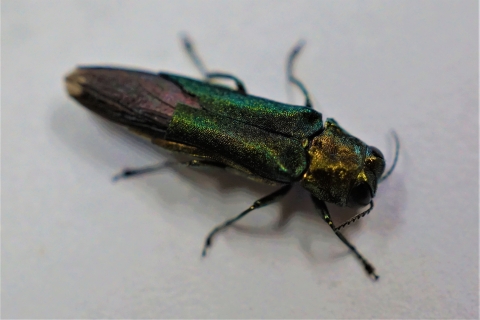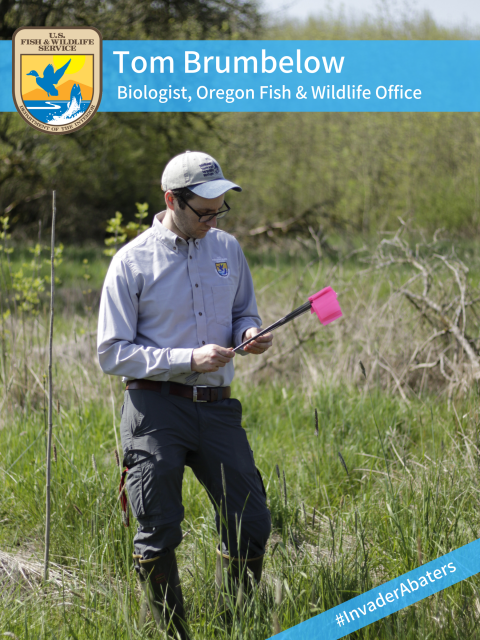Time flies, so do invasive species invasive species
An invasive species is any plant or animal that has spread or been introduced into a new area where they are, or could, cause harm to the environment, economy, or human, animal, or plant health. Their unwelcome presence can destroy ecosystems and cost millions of dollars.
Learn more about invasive species
A few short years ago in 2019, I was working with colleagues to put together a campaign around invasive species in the Pacific Northwest. From the infamous American bullfrog to the obscure aquatic hydrilla, the first step in fighting invaders is awareness. One of the best ways to raise awareness is via video and, as luck would have it, a U.S. Fish and Wildlife Service biologist, Tom Brumbelow was way ahead of me.
Originally from New York, he was eager to talk about another arrival he was well acquainted with, the emerald ash borer (Agrilus planipennis). This invasive and destructive insect has been found in the Pacific Northwest for the first time this summer.
Back then, Brumbelow’s message was a public service announcement designed to inform audiences about how to spot the signs of an invasion that we didn’t think had yet landed. Three years and a confirmed sighting by Oregon Department of Forestry later, his new message is a call for help.
“In 2019 we were all about awareness of this problem, and now we need to go beyond awareness to action,” says Brumbelow.
Know thy enemy
In order to understand how best to take action, a primer on the emerald ash borer, the ash trees they infest, and the impact the former has on the latter is helpful (check out this handy link from Oregon State to identify Oregon ash trees).
The Oregon ash tree is found from southern British Columbia to southern California but grows abundantly in Oregon, especially in the Willamette Valley. In good growing conditions ash trees can reach up to 80-feet tall and 16 to 30 inches in diameter, though occasionally they get even larger in especially nutrient rich sites. When healthy, the lifespan of these graceful trees can top 200 years.
Oregon ash are ecologically unique and important in riparian riparian
Definition of riparian habitat or riparian areas.
Learn more about riparian areas, providing shade to keep streams cool. This is essential for aquatic species such as salmon. Their root systems also provide soil stability, reducing erosion and sedimentation. Along with keeping the waterways cool and the soil together, Oregon ash trees act as a food and habitat source for native species — native larval insects eat their leaves and birds and small mammals eat their seeds and utilize standing and downed trunks as habitat.
The emerald ash borer was first found in North America in 2002 near Detroit, Michigan, having likely arrived on solid wood packing material carried in cargo ships or airplanes originating in its native Asia. A small, metallic green wood-boring insect, the emerald ash borer – as its name implies – feeds on ash trees. The adult beetles nibble on ash foliage but cause little damage. The real damage comes from the larvae feeding on the inner bark and outer sapwood of ash trees, disrupting the tree's ability to transport water and nutrients and ultimately leading to mortality.
Once the emerald ash borer sinks its mandibles into an ash tree, the havoc begins. About 99% of infested ash trees native to the U.S. die, causing widespread damage to natural and urban forests and often leading to complete losses of ash tree populations within 10 years. The ash borer can also infest other trees in the olive family, including white fringetree and commercial olive trees. In the last two decades, this invasive insect has left a path of destruction felt far and wide. From the estimated 100 million or more trees killed in forests around the country to the billions of dollars lost by property owners and nursery operators, the emerald ash borer is an environmental and financial pest of epic proportions. According to the Emerald Ash Borer Information Network, as of June 2022, it is now found in 36 states, and the Canadian provinces of Ontario, Quebec, New Brunswick, Nova Scotia and Manitoba.
“This extensive damage to the trees has devastating ripple effects on entire ecosystems, and it takes an extensive network of partners to fight back,” says Brumbelow.
Teaming up and asking tough questions
Shortly after the confirmed discovery of emerald ash borer at the end of June, the Oregon Department of Agriculture, Oregon Department of Forestry, Oregon State University, and Oregon Invasive Species Council pulled together a coalition of federal, state, and local partners to form an Emerald Ash Borer Task Force to address the diverse challenges ahead. “We are incredibly fortunate,” says Brumbelow, “that our partners at Oregon Department of Forestry had the foresight to begin preparing for this day before it arrived.”
In anticipation of the eventual arrival of emerald ash borer, the Oregon Department of Forestry brought stakeholders together to prepare the Emerald Ash Borer Readiness and Response Plan which was finalized in 2021. Thanks to funding from the U.S. Forest Service, they have also been able to collect Oregon ash seeds to preserve the species’ genetic diversity and conduct resistance trials ahead of anticipated devastation. An invasive pest reporting website (Oregon invasive species online hotline), and online field detection course (Oregon Forest Pest Detectors) were also established in advance of emerald ash borer.
The task force benefits from a diversity of specialties and interests among members. Brumbelow and his Service colleagues are focusing on surveying, monitoring, and participating in subcommittees to try to answer pressing questions:
- How fast is emerald ash borer likely to spread here compared to other places?
- How can we best slow it down?
- How is loss of ash in riparian areas going to affect aquatic species and communities as seasons change?
- What trees are going to be best suited ecologically to plant in different habitats as ash tree numbers decline?
This last question is particularly challenging because Oregon ash is one of a kind. While Oregon ash can grow as a component of a mixed forest stand in some places, there is no direct native replacement for Oregon ash in regard to moisture tolerance, growth rate, total size, and longevity. Figuring out the best trees to plant to ensure continuity of ecosystem services is going to take time.
“Time is of the essence,” says Brumbelow. “It takes time to figure out how to mitigate the damage of emerald ash borer, and we aren’t sure how much time we have in any given location.” Detection of an infestation in the early stages can be challenging because it takes about two years for the more obvious signs and symptoms of infestation like thinning canopy, top kill, splitting bark, and D-shaped exit holes to be visible from the ground. By that time, emerald ash borer could have already completed a life cycle and dispersed farther out.
Facing reality and finding hope for the future
Along with the ecological and economic toll invasive species bring, there is an emotional toll.
“When I first read that emerald ash borer had officially arrived in Oregon, I processed a number of different feelings” says Brumbelow. “The first, perhaps unsurprisingly, was dread. One of the most destructive forest pests in North America is here now.”
Brumbelow, as someone who had witnessed the fallout of emerald ash borer back east and in the upper Midwest, was upset thinking about his new home the Willamette Valley being ravaged by this invader. This change won’t take place overnight, but Brumbelow and his colleagues warn that the Pacific Northwest will, unfortunately, be altered by the ash borer.
All is not lost, however. Though we live in a time where so much may feel out of control, we also live in a time where we have more tools than ever to adapt and deal with issues like emerald ash borer. Emerald ash borer has only been found so far in Washington County in Oregon and the Pacific Northwest is a region where people love their wild places and green spaces, with an engaged community who seek to be stewards of the environment. We’re armed with 20 years of lessons learned from emerald ash borer’s spread across the continent, an engaged network of professionals in both public service and private enterprise, and a body of existing research on tree conservation.
As emerald ash borer has ravaged the landscape in other places, some ash trees have survived and are being investigated as sources of genetic resistance that can be the parents to new generations of trees that can eventually be planted back out on the landscape. The Service is collaborating with partners such as the Forest Service, for instance, which is using innovative science to breed trees that are more resistant to pests and disease.
“What the future looks like depends on the choices we make now and over the coming years,” says Brumbelow. “I’m optimistic because we have the tools and the commitment to play a positive role in the change that has come to our doorstep.”
What the public can do:
To report sightings of emerald ash borer please make a report online at the Oregon Invasive Species Council hotline.
Emerald ash borer look-alikes: https://www.oregon.gov/oda/programs/IPPM/SurveyTreatment/Documents/EABLookAlikes.pdf
For more information about impacts of emerald ash borer to Oregon’s urban forests and the risks to native ash trees please visit Oregon Department of Forestry’s Forest Health page.





